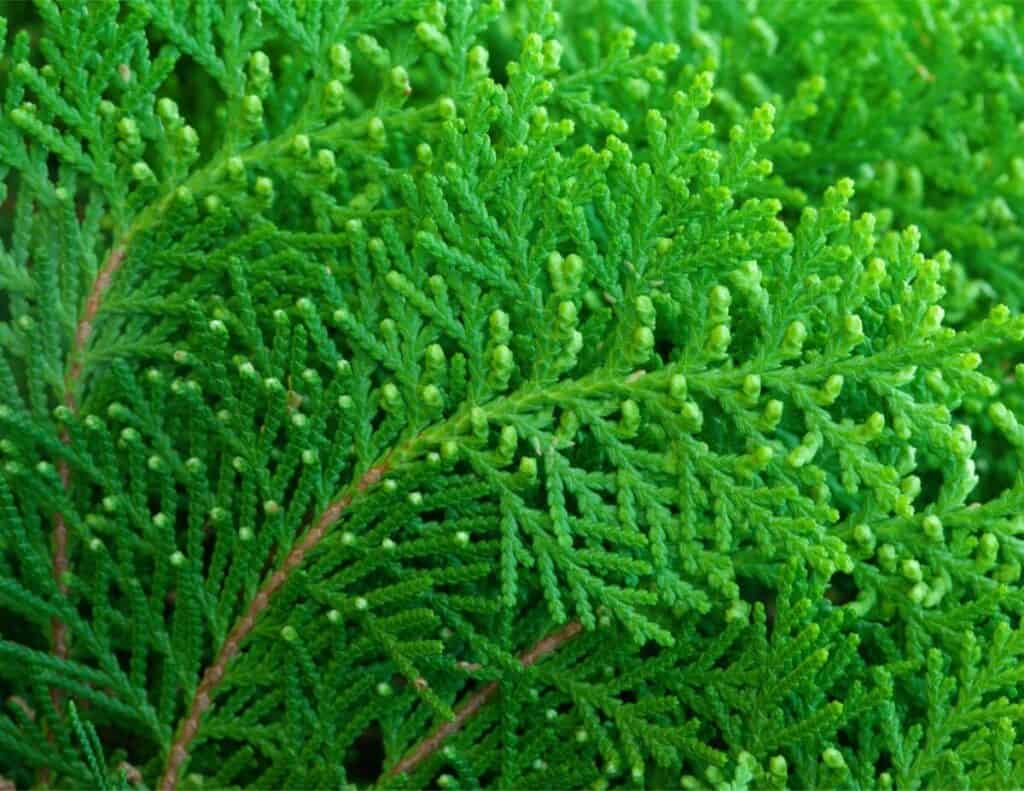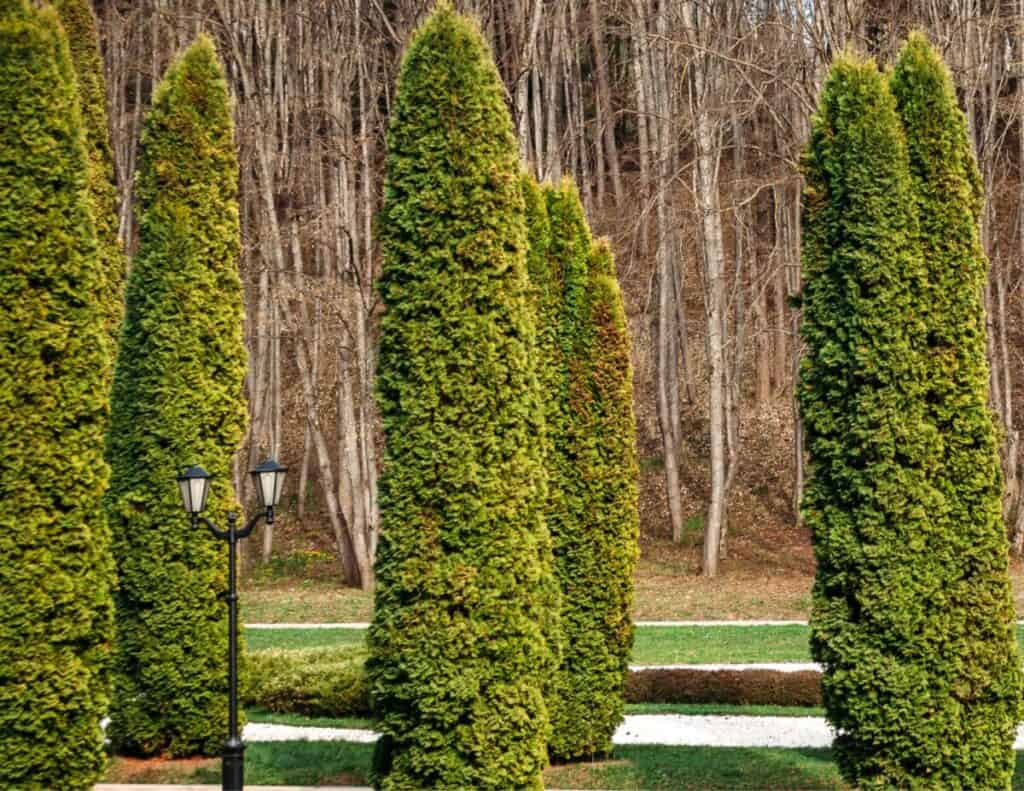
Arborvitae trees are a popular choice for homeowners who want to add privacy to their outdoor space. These trees are fast-growing and easy to care for, making them an ideal option for those who want to create a natural barrier around their property. However, like any other tree, arborvitae requires regular pruning to maintain its shape and health.
Trimming arborvitae trees is a task that requires attention to detail and a careful approach. If done incorrectly, it can cause damage to the tree and even lead to its death.
For this article, I will provide you with essential tips on how to trim arborvitae trees properly. I will cover everything from when to prune to the tools you need to get the job done. No matter if you’re a seasoned gardener or a beginner, this guide will help you keep your arborvitae trees healthy and looking their best.
How to Trim Arborvitae Trees
Trimming arborvitae trees is an important part of their maintenance and can help keep them healthy, attractive, and properly shaped. Here’s a step-by-step guide on how to trim arborvitae trees:
- Timing: The best time to trim arborvitae trees is during late winter or early spring before new growth begins. Avoid trimming during hot summer months as it may stress the tree.
- Assess the Tree: Start by examining the tree and identifying the branches that need trimming. Look for any dead, damaged, or diseased branches that should be removed.
- Gather the Necessary Tools: Equip yourself with the right tools, including pruning shears or loppers for smaller branches, and a pruning saw for thicker branches. Make sure your tools are sharp and clean.
- Safety Precautions: Wear protective gear such as gloves, safety goggles, and sturdy footwear to prevent any injuries while trimming.
- Start with Dead or Damaged Branches: Begin by removing any dead, damaged, or diseased branches. Cut them back to the trunk or the nearest healthy branch. Make clean cuts at a slight angle just outside the branch collar (the swollen area where the branch meets the trunk).
- Maintain the Desired Shape: To shape the arborvitae tree, trim back the longest branches to maintain a natural, tapered shape. Start from the top and work your way down, trimming each branch slightly shorter than the one below it. This helps maintain an even appearance.
- Avoid Cutting Into Old Wood: Avoid trimming too far back into old wood as it may not sprout new growth. Focus on shaping the outer portions of the tree and maintaining a balanced look.
- Step Back and Assess: Regularly step back to evaluate the tree’s appearance as you trim. This allows you to make adjustments and ensure a symmetrical shape.
- Remove Debris: As you trim, collect and remove any fallen branches or clippings. This helps maintain a tidy and clean landscape.
- Post-Trimming Care: After trimming, water the arborvitae tree thoroughly to help it recover from the stress of pruning. Apply a layer of mulch around the base of the tree to conserve moisture and prevent weed growth.
Remember, it’s important not to over-prune arborvitae trees, as this can lead to bare patches and affect their overall health. Aim to remove no more than one-third of the tree’s foliage in a single pruning session.
If you have a large or mature arborvitae tree that requires extensive pruning, it may be best to consult a professional arborist for guidance and assistance.
Why Trim Arborvitae Trees?
Trimming arborvitae trees is important for maintaining their shape and appearance, promoting healthy growth, preventing overcrowding, controlling size, enhancing light penetration, managing disease and pests, and ensuring safety.
However, excessive pruning should be avoided to prevent damage and stress to the tree. Moderate and selective trimming is recommended to preserve the tree’s health and natural beauty.
Here is some more detail on why it is important to trim arborvitae trees:
- Maintaining Shape and Appearance: Regular trimming helps to shape arborvitae trees and maintain their desired form. By removing overgrown or wayward branches, you can promote a neat and aesthetically pleasing appearance.
- Encouraging Healthy Growth: Trimming arborvitae trees stimulates new growth by removing dead, damaged, or diseased branches. This allows the tree to focus its energy on healthy foliage and promotes overall vitality.
- Preventing Overcrowding: As arborvitae trees grow, their branches can become densely packed, limiting airflow and sunlight penetration. Trimming helps to thin out the branches, reducing overcrowding and creating better conditions for the tree.
- Controlling Size: Arborvitae trees can grow quite tall and wide. Regular trimming allows you to control their size and prevent them from encroaching on nearby structures, obstructing views, or interfering with utility lines.
- Enhancing Light Penetration: Trimming arborvitae trees opens up their canopy, allowing more sunlight to reach the inner branches and lower portions of the tree. This promotes better overall health and helps prevent the development of sparse or bare areas.
- Disease and Pest Management: Trimming can help identify and remove diseased or infested branches, reducing the risk of spreading infections or attracting pests. It also improves air circulation, creating a less favorable environment for fungal diseases.
- Safety and Structural Integrity: Trimming removes weak or damaged branches that could pose a safety hazard during storms or high winds. By maintaining a strong and well-structured tree, you reduce the risk of branches breaking and causing property damage or personal injury.

When to Prune Arborvitae
The best time to prune arborvitae trees is in late winter or early spring before new growth appears. Avoid pruning in the summer as this can cause stress to the tree. If you need to remove diseased or damaged branches, do so promptly to prevent the spread of disease.
Tools Needed for Pruning Arborvitae Trees
When pruning arborvitae trees, it’s important to have the right tools to ensure a clean and effective job. Here are the tools you’ll need:
- Pruning Shears: These are essential for trimming smaller branches and foliage. Choose a pair of sharp bypass pruning shears, which have two curved blades that bypass each other, providing a clean cut without crushing the branch.
- Loppers: For thicker branches that pruning shears can’t handle, loppers come in handy. They have longer handles and larger cutting blades, allowing you to cut branches with a diameter of up to 2 inches or more.
- Pruning Saw: When dealing with larger branches or removing entire branches, a pruning saw is necessary. Look for a pruning saw with a curved blade and sharp teeth designed specifically for cutting through tree branches.
- Pole Pruner: If your arborvitae trees are tall and have branches out of reach, a pole pruner can be useful. It consists of a long pole with a pruning head at the end, operated by pulling a rope or using a lever mechanism. This allows you to trim high branches while standing on the ground.
- Safety Gear: Always prioritize safety when pruning trees. Wear thick gloves to protect your hands from cuts and scratches. Safety goggles or glasses are crucial to shield your eyes from falling debris. Additionally, consider wearing ear protection if you’ll be using power tools.
- Ladder or Step Stool: Depending on the height of the tree, you may need a stable ladder or step stool to reach higher branches safely. Ensure the ladder is in good condition and positioned securely on a flat surface.
Before using any tools, ensure they are clean, sharp, and in proper working condition. Dull blades can cause damage to the tree and make pruning more challenging.
How to Prune Arborvitae Trees
To prune arborvitae trees, start by removing any dead or diseased branches. Next, thin out the interior of the tree by removing any crossing or rubbing branches. This will improve air circulation and reduce the risk of disease.
If you need to reduce the height of the tree, do so gradually over several years by cutting back the leader no more than a third each time. Avoid cutting back more than half of the tree as this can cause harm.
- Natural Shape: Lightly trim the tips of the branches.
- Formal Look: Shear the tree to a pyramid shape.
- Dense Hedge: To maintain a dense hedge, trim the lower branches to encourage vertical shoots to grow.

Maintaining Arborvitae Trees
Arborvitae trees are popular evergreen shrubs that can add structure and beauty to any landscape design. However, to keep them healthy and looking their best, proper maintenance is essential.
Watering and Fertilizing Arborvitae Trees
During the first year after planting, it is important to water the tree deeply once a week. After the first year, the tree may not require as much watering, but it is still important to keep the soil moist. Avoid overwatering, as this can lead to root rot and other diseases.
Fertilizing arborvitae trees can also help promote healthy growth. Apply a slow-release fertilizer in early spring, and then again in early fall. Alternatively, you can use compost to fertilize the tree. Spread a layer of compost around the base of the tree, being careful not to cover the trunk.
Protecting Arborvitae Trees from Pests and Diseases
Arborvitae trees are susceptible to several pests and diseases, including deer, needle blight, and spider mites. To protect your tree from deer, consider using a deer repellent or installing a fence around the tree.
To prevent diseases, it is important to keep the tree healthy. Avoid planting arborvitae trees in areas with poor drainage, as this can lead to root rot. If you notice any signs of disease, such as dead or diseased foliage, remove the affected branches immediately.
Shaping Arborvitae Trees
Shaping arborvitae trees is an important part of maintenance. Light trimming can be done throughout the year to maintain the tree’s shape. However, heavy pruning should be done in late winter or early spring while the tree is still dormant.
When pruning arborvitae trees, it is important to use proper techniques. Use a reduction cut to shorten the overall length of a branch, and a removal cut to eliminate a branch altogether. Avoid cutting into the tree’s horizontal branches, as this can damage the tree’s structure.

Soil Care for Arborvitae Trees
Proper soil care is crucial for the health and growth of arborvitae trees. Here are some important considerations for maintaining optimal soil conditions:
- Soil Type: Arborvitae trees generally prefer well-drained soils that are rich in organic matter. They can tolerate a range of soil types, including loam, clay, and sandy soils, as long as they are well-drained. Avoid planting arborvitae in waterlogged or compacted soils, as this can lead to root rot and poor growth.
- Soil pH: Arborvitae trees thrive in slightly acidic to neutral soil conditions, with a pH range between 6.0 and 7.5. Test the soil pH using a soil testing kit and adjust it if necessary. If the soil is too acidic, you can raise the pH by adding lime. Conversely, if the soil is too alkaline, you can lower the pH by adding organic matter like compost or sulfur.
- Organic Matter and Mulching: Incorporating organic matter into the soil improves its structure, drainage, and nutrient-holding capacity. Add compost, well-rotted manure, or other organic materials to the soil around the base of the tree. Additionally, apply a layer of organic mulch, such as wood chips or bark, around the tree to conserve soil moisture, regulate temperature, and suppress weed growth. Mulch also gradually breaks down and enriches the soil with organic matter.
- Irrigation: Arborvitae trees require consistent moisture, especially during the first few years after planting. Adequate irrigation is crucial for establishing healthy root systems. Water the trees deeply but infrequently to encourage deep root growth. Provide enough water to moisten the top 8-12 inches of soil. Avoid overwatering, as it can lead to root rot. Monitor soil moisture regularly and adjust watering frequency based on weather conditions.
- Fertilization: Arborvitae trees generally have moderate fertilizer requirements. Before applying any fertilizers, conduct a soil test to determine nutrient deficiencies. Based on the test results, you can provide appropriate fertilizers to address specific nutrient needs. Use slow-release fertilizers designed for trees and shrubs, following the manufacturer’s instructions. Apply fertilizers in early spring or late fall to ensure proper absorption and utilization by the tree.
- Avoid Compacting the Soil: Be mindful of foot traffic or heavy machinery around the base of arborvitae trees, as compacted soil can restrict root growth and lead to nutrient deficiencies. Avoid driving or parking vehicles near the trees and minimize foot traffic in their vicinity.
How Soil Care Relates to Healthy Branches and Trimming
Soil care plays a significant role in the health of arborvitae trees, which, in turn, affects the condition of their branches and the need for trimming. Here’s how soil care relates to healthy branches and trimming:
- Nutrient Availability: Proper soil care ensures that the soil is rich in essential nutrients. Nutrient deficiencies can weaken the overall health of the tree, including its branches. When the soil lacks vital nutrients, arborvitae trees may exhibit stunted growth, sparse foliage, or weak branches that are more prone to breakage.
- Vigorous Growth: Healthy soil conditions contribute to vigorous growth in arborvitae trees. When the soil is well-nourished and properly drained, the tree can develop a strong root system and absorb water and nutrients efficiently. Robust root systems support the growth of healthy branches, which are less likely to become diseased or damaged.
- Disease Prevention: Soil care indirectly affects the susceptibility of arborvitae trees to diseases and pests. Unhealthy soil conditions, such as poorly drained or nutrient-deficient soil, can weaken the tree’s immune system, making it more vulnerable to infections and infestations. Sick or stressed trees are often more prone to branch dieback, requiring more frequent trimming to remove diseased or damaged branches.
- Water Management: Soil care includes maintaining adequate soil moisture levels. Proper watering techniques and soil moisture management prevent drought stress or waterlogging, which can negatively impact branch health. Insufficient watering can lead to dry, brittle branches that are more prone to breakage. On the other hand, excessive water accumulation can cause root rot and weaken the tree’s stability, potentially resulting in branch failure.
Final Thoughts
Trimming an arborvitae tree can be a daunting task, but with the right tools and techniques, it can be done successfully. Remember to avoid cutting too much of the foliage, and only cut into green, young wood. Work in sections to make fewer mistakes and avoid cutting horizontal branches.
When pruning your arborvitae, it’s important to keep in mind the reasons for pruning. Whether you want to control the height or width of the tree, or simply remove dead or damaged branches, pruning should be done with care and precision.
Timing is also crucial when it comes to pruning arborvitae. Early spring is a good time for heavy pruning, as new growth hasn’t started yet. This will also help hide any cuts made to the tree.
